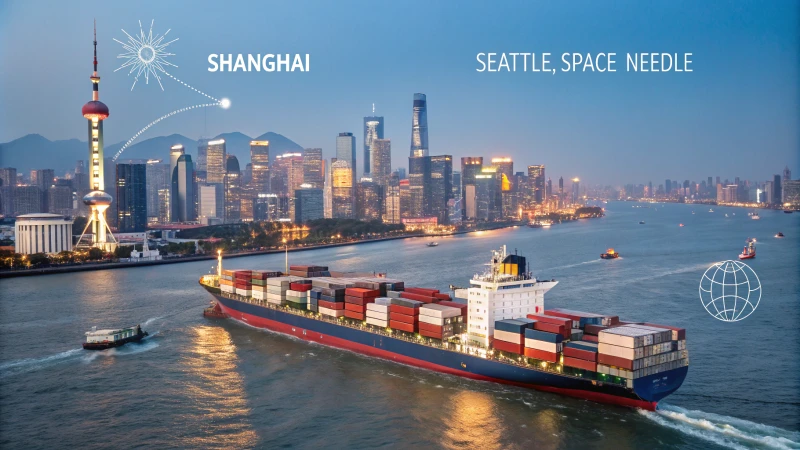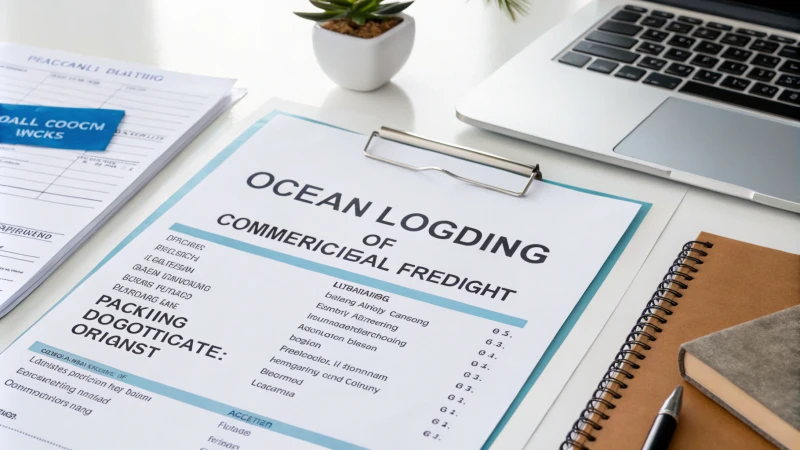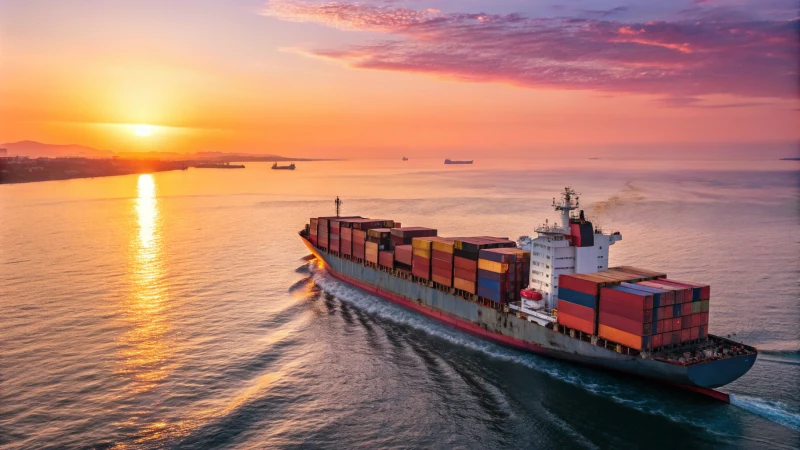Finding your way through the complex world of international shipping feels really confusing, especially with ocean freight from Shanghai to Seattle. I know this feeling. Believe me, it is a journey worth knowing.
When shipping goods from Shanghai to Seattle, you have two main options꞉ Full Container Load (FCL) or Less than Container Load (LCL). Understanding these choices is important. Costs, transit times and customs rules also matter for a successful shipment. Learn about the shipping process to save time and money. This knowledge helps your goods arrive safely and on time.
Starting my journey in importing goods, I found ocean shipping very intimidating. However, knowing your choices is important. You face two main choices꞉ Full Container Load (FCL) or Less than Container Load (LCL). Each choice affects costs and delivery times. FCL works well for large shipments. LCL helps you save money on smaller loads. Understanding these details really changes a stressful experience into an easy one. It really does.
Shipping from Shanghai to Seattle involves complex regulations.True
International shipping has numerous regulations that must be adhered to, making it complex.
FCL is always cheaper than LCL for ocean freight.False
The cost-effectiveness of FCL versus LCL depends on shipment size and specifics, not always cheaper.
What are the main differences between FCL and LCL shipping?
Shipping often feels really complicated, right? I recall my first time choosing between FCL and LCL for my business. Learning the differences truly changed everything for me. It could probably change everything for you too!
The main differences between FCL (Full Container Load) and LCL (Less than Container Load) shipping include cost efficiency, speed, flexibility and risk of damage. FCL fits large shipments. LCL suits smaller loads.
Understanding FCL Shipping
Full Container Load (FCL) shipping is a method where an entire shipping container is utilized by a single shipper for their cargo. This option is generally more cost-effective for larger shipments that can fill a container.
Key Characteristics of FCL:
- Dedicated Space: Only your products go inside, which assures me they are safe.
- Lower Cost Per Unit: Larger shipments become cheaper per item. My bulk orders save me a lot.
- Faster Transit Times: Generally quicker because the container goes directly to its endpoint without stops.
This makes FCL ideal for businesses like mine that import many consumer electronics. If you wonder about the FCL advantages1, check it out!
Exploring LCL Shipping
Less than Container Load (LCL) shipping allows multiple shippers to share the space in a single container. This method is beneficial for smaller shipments that do not fill an entire container.
Key Characteristics of LCL:
- Shared Costs: Costs split among different shippers, making it affordable for small shipments.
- Flexibility: Great for shipping smaller quantities often without needing a full container.
- Longer Transit Times: Takes more time due to loading and unloading stages at ports. Patience is necessary!
LCL can be advantageous when I must import smaller amounts without overcommitting. For extra details on the LCL benefits2, take a look!
Comparing FCL and LCL
Here’s a comparison table to clearly outline the differences between FCL and LCL:
| Feature | Full Container Load (FCL) | Less than Container Load (LCL) |
|---|---|---|
| Cost | Generally lower per unit for larger shipments | Shared costs, higher per unit for small shipments |
| Speed | Faster due to direct routes | Slower due to multiple stops |
| Flexibility | Less flexible, must fill entire container | More flexible, can ship small quantities |
| Risk of Damage | Lower risk, dedicated space | Higher risk due to shared space |
This table should help evaluate which option suits your shipping needs best. If you're still unsure, consider checking out cost comparisons3 for FCL vs LCL.
FCL shipping is more cost-effective for large shipments.True
Full Container Load (FCL) offers lower costs per unit when shipping larger volumes, making it ideal for bulk shipments.
LCL shipping allows multiple shippers to share container space.True
Less than Container Load (LCL) enables various shippers to utilize a single container, reducing costs for smaller shipments.
What do I need to know to calculate shipping costs from Shanghai to Seattle?
Shipping goods around the globe feels confusing. Calculating costs from Shanghai to Seattle seems daunting. But no need to stress! This guide simplifies everything. I speak from experience.
To estimate shipping costs from Shanghai to Seattle, look at factors like shipping method (FCL or LCL) and container size. Container size plays a big role. Think about extra fees like customs duties and fuel surcharges. Insurance options also influence the total price.

To calculate shipping costs from Shanghai to Seattle, several factors come into play. Understanding these factors will not only help you estimate costs but also assist in making better logistics decisions.
1. Shipping Methods
Different shipping methods come with varied costs and transit times. The two primary options are:
| Shipping Method | Description | Estimated Time |
|---|---|---|
| Full Container Load (FCL) | Best for large shipments that fill a container. | 15-20 days |
| Less than Container Load (LCL) | Ideal for smaller shipments sharing container space. | 15-20 days |
I felt surprised when I discovered how the shipping method choice changed my costs. Knowing this was key to saving money. Large shipments often need FCL because it is very economical. Smaller shipments really fit well with LCL. Really think about what you need. For more on these methods, visit shipping methods4.
2. Container Size and Weight
The size and weight of your shipment are crucial in determining costs. Shipping containers come in various sizes:
| Container Size | Dimensions (ft) | Max Weight (kg) |
|---|---|---|
| 20' Standard | 20 x 8 x 8.5 | 22,000 |
| 40' Standard | 40 x 8 x 8.5 | 30,480 |
| 40' High Cube | 40 x 8 x 9.5 | 30,480 |
Measuring your cargo size and weight is very important. Larger and heavier cargo usually means more fees. Correct measurements help avoid extra charges. Learn about container sizes at container sizes5.
3. Additional Fees and Charges
Shipping costs often include additional fees, such as:
- Customs Duties: Taxes imposed by the destination country.
- Fuel Surcharges: Variable costs related to fuel prices.
- Handling Fees: Charges for loading and unloading your cargo.
Surprise fees can occur when shipping, including:
- Customs Duties: Taxes from the destination country.
- Fuel Surcharges: Costs changing with fuel prices.
- Handling Fees: Costs for loading and unloading.
Researching these costs helped me understand all my expenses. Discover more at additional fees6.
4. Insurance and Tracking Options
Opting for insurance coverage can protect your goods against potential loss or damage during transit; it depends a lot on shipment value.
Insurance is vital for protection against loss or damage; I felt uneasy without insurance at first.
Tracking options also may add to the shipping cost, but they provide peace of mind by allowing you to monitor your shipment’s progress in real-time; tracking makes shipping costs rise but offers real-time updates for peace.
For options, check insurance options7.
5. Carrier Services Comparison
Comparing carriers like UPS, FedEx, and USPS was valuable as they offer different rates and services for international shipping; remember these when comparing:
- Delivery speed
- Service dependability
- Customer feedback
Utilizing online calculators provided by these carriers can simplify the comparison process, helping you find the best deal for your shipment; carrier online calculators are really helpful in finding the best option.
it's wise to look at a shipping calculator8 for easier comparison.
By carefully evaluating these factors, you'll handle shipping costs from Shanghai to Seattle better by checking all these details; with this knowledge, make smart logistics choices tailored to your needs.
FCL shipping is more economical for large shipments.True
Full Container Load (FCL) is cost-effective for large shipments, reducing per-unit costs compared to sharing container space with Less than Container Load (LCL).
Shipping costs include customs duties and fuel surcharges.True
Shipping fees often encompass additional charges like customs duties and fuel surcharges, which can significantly affect the overall cost of shipping.
What documents do I need for ocean freight shipments?
Shipping goods across the ocean? Learn about the important papers needed for easy shipping! These documents aren't just forms; they provide peace of mind while your goods move around the world. It's really good to have them!
Shipping goods by ocean requires important documents such as a Bill of Lading, Commercial Invoice, Packing List, Certificate of Origin, Import/Export Licenses and an Insurance Certificate. These documents are really necessary.

Understanding the Essential Documents for Ocean Freight
When I began my journey in international shipping, I felt lost in a pile of papers. It felt scary, but I learned fast. Having the correct papers is very important. These are the main documents I always keep ready:
-
Bill of Lading (B/L): This is like the heartbeat of your shipment. It’s a contract between you and the carrier, with details about the type and quantity of goods and their final stop. It also serves as a receipt when the cargo arrives.
-
Commercial Invoice: This is like a sales ticket. It includes every detail about the deal between you and your buyer, such as the goods' value and terms of sale. Customs use this document to clear your shipment and set any duties or taxes.
-
Packing List: Think of it as your packing checklist! It outlines what’s inside each package, including weight and size, which helps during customs checks.
-
Certificate of Origin: This small paper has a big role! It shows where your goods were made and can change tariff rates based on trade pacts. Customs might need this to follow the rules.
-
Import/Export Licenses: Depending on your cargo, some licenses might be necessary. This is true for controlled or limited items, so it's crucial to know the regulations affecting your shipment.
-
Insurance Certificate: Shipping has risks and an insurance certificate protects you in case of loss or damage. It’s a relief to have that protection!
Additional Documentation Considerations
Aside from the basic documents, others might be needed based on your shipment:
- Health Certificates: Required for shipping food products or medicines to ensure safety.
- Dangerous Goods Declaration: Necessary for hazardous materials to ensure safe handling and compliance with rules.
Working with a freight forwarder or customs broker can really save you trouble. They know the details and assist in preparing the paperwork to avoid delays.
Preparing for Customs Clearance
Accurate documentation for customs clearance is very important. Missing or incorrect documents cause delays or extra charges.
| Document Type | Purpose | Notes |
|---|---|---|
| Bill of Lading | Contract between shipper and carrier | Must be signed by both parties |
| Commercial Invoice | Details transaction information | Should include all charges |
| Packing List | Breakdown of contents | Helps customs verify contents |
| Certificate of Origin | Certifies manufacturing country | May affect tariffs |
| Import/Export Licenses | Compliance with government regulations | Check local laws |
| Insurance Certificate | Proof of coverage for shipment | Protects against loss |
By being ready with these documents, the shipping process becomes smoother without extra problems.
Final Thoughts
In my early shipping days, gathering all these documents felt daunting. But breaking it down into steps made it easier! Stay updated on changes in rules that might affect shipping practices. For more help on international shipping, check out freight forwarding best practices9.
With all documents ready and submitted on time, a smooth ocean freight journey awaits. Goods deserve to reach their destination without any trouble!
A Bill of Lading is not required for ocean freight shipments.False
The Bill of Lading is essential as it serves as a contract and receipt for the goods shipped.
An Insurance Certificate protects against shipment loss or damage.True
The Insurance Certificate provides proof of coverage, safeguarding against potential losses during transit.
What common delays should I expect in ocean freight?
Understanding ocean freight might seem scary, especially when delays could disturb your plans. Some common obstacles might pop up on your journey.
Delays in ocean freight often occur due to documentation problems, worker strikes, bad weather and crowded ports. Understanding these reasons helps with better planning. It also reduces their effect on your shipping schedule.
When shipping goods via ocean freight, delays can be a significant concern for importers and exporters alike. Understanding these common delays can help businesses better manage their logistics strategies.
Documentation Issues
One of the most frequent causes of delays in ocean freight is improper or missing documentation. Common documents include:
| Document Name | Purpose |
|---|---|
| Bill of Lading | Serves as a receipt for cargo and a contract between carrier and shipper |
| Commercial Invoice | Details the items shipped, including their value |
| Packing List | Provides a detailed list of items in the shipment |
| Customs Declaration | Required for clearing goods through customs |
Failure to provide accurate documentation can lead to customs holds and shipping delays. Therefore, it is crucial to ensure that all paperwork is complete and correct before shipment. For more details, explore documentation tips10.
Labor Disruptions
Labor issues can also contribute to delays in ocean freight. Strikes or shortages in labor can slow down loading and unloading processes at ports. For instance, during peak seasons or in the wake of global events, labor availability can fluctuate significantly. This can lead to longer turnaround times at ports and increased shipping costs. Understanding labor trends and planning shipments accordingly can help mitigate these delays. Learn more about labor impacts on shipping11.
Weather Conditions
Adverse weather conditions can halt shipping operations altogether, especially during hurricane season or winter storms. Shipping routes may need to be adjusted for safety, resulting in longer transit times. Regularly monitoring weather forecasts and planning shipments during favorable weather windows can help avoid these disruptions. For insights on weather patterns affecting shipping12, check out this resource.
Port Congestion
Port congestion is another common delay in ocean freight logistics. High volumes of incoming vessels can lead to bottlenecks at major ports, causing delays in unloading cargo. This issue is often exacerbated during peak shipping seasons or due to unforeseen circumstances such as natural disasters or pandemics. Businesses should prepare for potential delays by planning for additional buffer times in their supply chain management. To learn how to navigate port congestion, read about strategies to avoid port delays13.
Improper documentation can cause significant shipping delays.True
Missing or incorrect documents lead to customs holds, delaying ocean freight shipments.
Labor shortages have no impact on ocean freight timelines.False
Labor disruptions can slow loading and unloading, significantly affecting shipping schedules.
Conclusion
Learn about ocean freight options from Shanghai to Seattle, including FCL vs. LCL shipping methods, cost factors, necessary documents, and common delays to ensure smooth logistics.
-
Learn about the specific benefits of FCL versus LCL to make informed shipping decisions for your business. ↩
-
Discover how LCL can be cost-effective for smaller shipments and its implications on transit times. ↩
-
Get detailed cost comparisons between FCL and LCL to determine the best shipping method for your needs. ↩
-
This link provides valuable insights on shipping calculators to help you estimate costs effectively. ↩
-
Learn about the different types of containers and their uses to better understand your shipping options. ↩
-
Get detailed information on additional shipping fees that could affect your budget. ↩
-
Discover insurance options for your shipment to ensure safety during transit. ↩
-
Explore comparisons of different carriers to find the best rates for your needs. ↩
-
This link offers best practices for freight forwarding which can help streamline your shipping process. ↩
-
Discover effective strategies to manage ocean freight delays and streamline your shipping process. ↩
-
Learn how labor disruptions can affect your shipping timelines and what you can do about it. ↩
-
Understand how weather affects shipping and find ways to prepare for such disruptions. ↩
-
Explore solutions for dealing with port congestion to ensure timely deliveries. ↩




